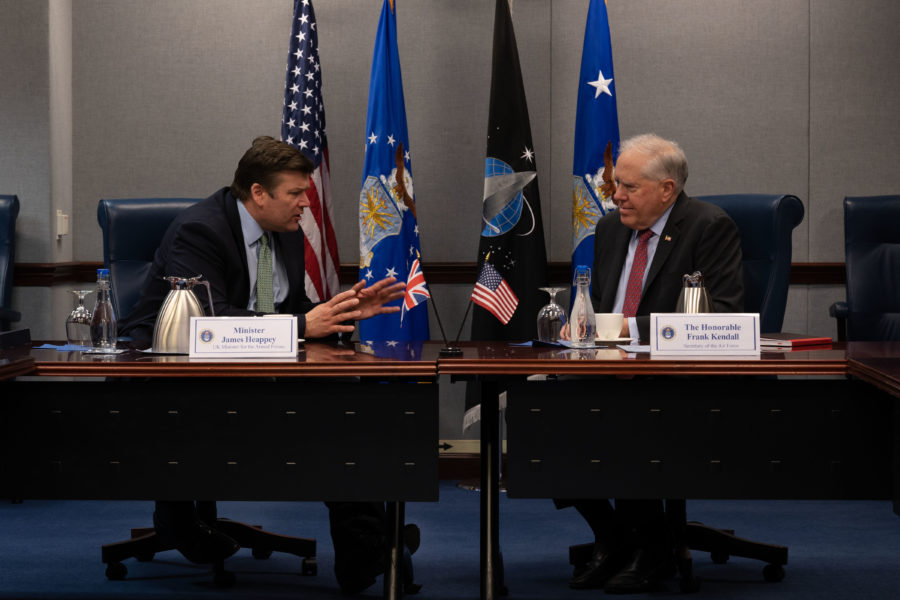Air Force Secretary Frank Kendall welcomed a top British defense official to the Pentagon on Feb. 8, for discussions on Russia’s war on Ukraine, U.K. moves to bolster its role in the Indo-Pacific, and new aircraft purchases by both the U.S. and Royal air forces.
A readout of Kendall’s meeting with U.K. Minister for the Armed Forces James Heappey offered new details on the E-7 Wedgetail, the airborne early warning and control aircraft both countries are buying to replace their aging E-3 AWACS fleets. The readout said the two discussed “continued collaboration on the E-7 Wedgetail program, including ways to accelerate U.S. Air Force procurement and fielding of the platform and the importance of achieving maximum interoperability.”
Under current plans, the Royal Air Force has ordered three Wedgetails, with the first being converted from a secondhand Boeing 737 Next Generation airliner. That first aircraft is to be delivered in 2024. The U.S. Air Force is procuring an as-yet-undisclosed number of E-7s, with the delivery of a first “rapid prototype” by 2027.
Yet soon after the USAF announced it was buying the Wedgetail in April 2022, discussions about potentially accelerating that 2027 delivery timeline started—driven in large part by the E-3’s rapidly declining reliability and the service’s eagerness to retire the old aircraft quickly, even to the point of accepting what it called a “small” gap in intelligence, surveillance, and reconnaissance.
Gen. Mark D. Kelly, head of Air Combat Command, said in October 2021 that he wanted the wanted the E-7 in the fleet “two years ago.” The E-3 fleet is now so old and rickety, he said, it requires a “Herculean” effort just to get mission capable rates up to about 50 percent.
Last May, Kendall told lawmakers “there are things that we could do … to maybe get access to aircraft earlier one way or another,” but he did not specify what. It takes two years to build the airframes themselves, let alone the specialized equipment on board. Modifying the 737 Next Generation airframes with the Wedgetail gear takes another two years, Kendall said then, indicating the U.S. was stuck behind other customers awaiting orders.
But two months later, Boeing executives told reporters at the Farnborough International Airshow in July that their company was ready and willing to accelerate the Wedgetail schedule, saying they could ramp up production of the 737 Next Generation airframes to start with. Then in August, program executive officer for the digital directorate Steven Wert suggested the RAF might be able to help accelerate the program.
“We see tremendous opportunities to accelerate test and evaluation, given that we’re buying a system very similar to the U.K. E-7,” Wert said at the time. “Much of the testing can actually be done on a U.K. E-7 or a Wedgetail. So tremendous opportunities, especially with test and evaluation.”
Kendall’s meeting with Heappey, one of the top deputies for U.K. defense secretary Ben Wallace, is the first public discussion since then.
Using British E-7s for test and evaluation ahead of a planned 2025 production decision seems the most likely way the RAF could help the process. Andrew Hunter, assistant secretary for acquisition, has previously said the U.S. Air Force does not want to buy used 737s and convert them like the U.K. has, so the British wouldn’t be able to give their aircraft to the U.S. or defer their buy.
F-35, Ukraine, Indo-Pacific
In addition to Wedgetail, Kendall and Heappey also discussed “aspects of the F-35 Lightning II program,” with Kendall in particular highlighting it as a “key to maintaining a strong and effective integrated deterrence posture in Europe.” The British are slated to buy 138 F-35s, while the U.S. is building up its first F-35 squadrons in Europe at RAF Lakenheath in England.
In addition to the U.K. and U.S., Germany, Switzerland, Finland, Belgium, Denmark, Italy, the Netherlands, Norway, and Poland have all either ordered or received F-35s—officials are predicting more than 500 of the fifth-generation fighters on the continent by the end of the decade.
Kendall and Heappey also talked about the situation in Ukraine and their commitment to supporting Ukrainian resistance against Russia’s invading forces, according to the readout. That same day, U.K. Prime Minister Rishi Sunak offered to extend fighter jet training to Ukrainian pilots, while directing Wallace to look into what combat jets the RAF could potentially supply to Ukraine.
Kendall “commended the U.K. for its commitment to security and stability in the Indo-Pacific region, as evidenced by the Reciprocal Access Agreement the U.K. recently signed with Japan,” the readout said.
The U.K.-Japan agreement, signed in January, allows forces from both countries to be deployed to the other for training and joint exercises, a further sign of growing U.K. involvement in the Indo-Pacific. Britain, Australia, and the U.S. are joined in AUKUS, a trilateral defense agreement, and the UK also is working with Italy and Japan to develop a next-generation fighter jet.
